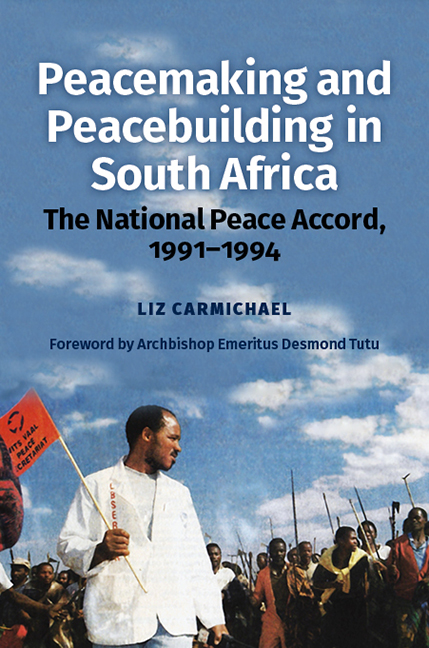Book contents
- Frontmatter
- Dedication
- Contents
- List of Illustrations
- List of Abbreviations
- Glossary
- Acknowledgements
- Note on Nomenclature
- Transition Timeline
- Foreword
- Introduction
- Part One Peacemaking, Peacebuilding, and the South African Conflict
- Part Two Peacemaking
- Part Three Peacebuilding
- Conclusion: Impact and Unfinished Business
- Bibliography
- Index
10 - Signing up to Peace: The National Peace Convention
Published online by Cambridge University Press: 08 October 2022
- Frontmatter
- Dedication
- Contents
- List of Illustrations
- List of Abbreviations
- Glossary
- Acknowledgements
- Note on Nomenclature
- Transition Timeline
- Foreword
- Introduction
- Part One Peacemaking, Peacebuilding, and the South African Conflict
- Part Two Peacemaking
- Part Three Peacebuilding
- Conclusion: Impact and Unfinished Business
- Bibliography
- Index
Summary
This historic day, quite unparalleled in the annals of our land.
Introduction
Members of the Preparatory Committee, staff, and delegates from afar spent Friday night in the Carlton Hotel, rising thirty stories from Main Street in the central business district. In its spacious second-floor conference hall, a blue backdrop and white table flags displayed the Convention logo. Registration tables bore 400 ‘briefcases’ containing the Accord, agenda, leaders’ statements, Peace Pledges for non-signatories, and an organogram of the projected peace structures. All was prepared for a seamless roll-out. Then came a surprise.
The impi and the Archbishop
At 6am, dawn broke and the street below came alive with several thousand uninvited guests, Zulus from the hostels complete with shields, sticks, knobkerries, spears and a scattering of less traditional sharp objects.
Ostensibly, they came spontaneously. The King's presence had been heralded in the media. ‘So’, Buthelezi unswervingly maintains, ‘I really wouldn't think there was anything mysterious about it, that people would quickly whip up feelings and say: “Let's go and honour the King.”’ He and his colleagues simply repeated: ‘You can't prevent them from honouring their King!’ Just one news report leaked what many suspected: ‘Derrick Mgaga, the IFP's Natal regional secretary, said word was sent out to IFP branches in the Transvaal to come to the Carlton yesterday, and to bring their “cultural weapons” because King Goodwill would be there.’
The crowd was hardly apolitical. Numerous IFP T-shirts and flags accompanied posters hailing Buthelezi as ‘Prince of peace’. A song proclaimed: ‘Mandela, you will not rule the world!’ A handwritten banner complained: ‘We die because our liberation movements are colonized or married to foreign “isms”’
Live TV coverage of the whole day, on a spare SABC channel, began at 8am. The ‘impi’ numbered around four thousand and growing. White public order (riot) police in camouflage but without rifles, nonchalant but nervous, lined a hastily cleared path to the entrance. They had offered to store ‘traditional weapons’ in a Casspir. There were no takers. An ANC observer would immediately think: ‘The police are doing nothing.’
- Type
- Chapter
- Information
- Peacemaking and Peacebuilding in South AfricaThe National Peace Accord, 1991-1994, pp. 166 - 198Publisher: Boydell & BrewerPrint publication year: 2022

